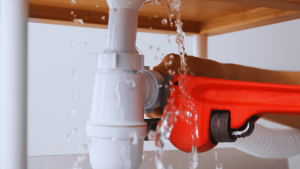Are you looking for a way to increase your kitchen’s functionality and storage space while also adding a stylish element to your home? Building a handy kitchen island is a great DIY project that can achieve all these goals! With the right tools, materials, and guidance, you can create a practical and beautiful kitchen island that fits your unique needs and preferences.
This DIY guide will provide you with step-by-step instructions and kitchen island building tips to help you bring your vision to life. From planning your design to adding finishing touches, we’ve got you covered!
Key Takeaways:
- The DIY approach to building a kitchen island can save you money and allow for customization.
- Proper planning is crucial to ensure a functional and handy kitchen island design.
- Gathering the necessary tools and materials ahead of time can save time and prevent frustration during the construction process.
Planning Your Kitchen Island Design
Before starting the construction process, it is important to plan your kitchen island design. This will ensure that you create a handy kitchen island that meets your specific needs and fits seamlessly into your kitchen space. Follow these step-by-step instructions for creating DIY kitchen island plans and designing a functional and stylish kitchen island.
Step 1: Assess Your Kitchen Space
Measure the available space in your kitchen to determine the size and shape of your kitchen island. Consider how the island will fit with your existing kitchen appliances and cabinetry. Take into account the traffic flow in the kitchen and ensure there is enough space around the island for people to move freely.
Step 2: Determine the Functionality
Decide how you will be using your kitchen island. Will it be used for food preparation, cooking, or dining? Or will it serve as extra storage or a workspace? This will determine the design features you incorporate into your kitchen island plan.
Step 3: Select the Materials
Select the materials you will use to build your kitchen island. This could include wood, metal, or a combination of materials. Make sure you choose materials that are durable, easy to clean, and fit with your existing kitchen decor.
Step 4: Consider the Details
Think about the details that will make your kitchen island both functional and stylish. Consider adding features such as built-in storage, a sink, a cooktop, or seating. Make sure these details fit with your overall kitchen design and are practical for your specific needs.
By following these steps and planning your kitchen island design upfront, you will be able to create a handy kitchen island that fits perfectly into your kitchen and improves your daily cooking and dining experience.
Gathering the Necessary Tools and Materials
Before starting your DIY kitchen island project, it is essential to ensure you have the proper tools and materials. In this kitchen island construction guide, we provide you with a comprehensive list of everything you will need to build a handy kitchen island that suits your needs.
Tools
| Tool | Purpose |
|---|---|
| Measuring tape | To ensure accurate measurements for the frame and countertop. |
| Saw | To cut the lumber pieces for the frame. |
| Drill | To secure the frame with screws or bolts. |
| Screwdriver | To turn screws and bolts when assembling the frame or installing hardware. |
| Sander | To smooth the wood surface and prepare it for finishing. |
| Paintbrush or roller | To apply paint or stain to the frame and countertop. |
Materials
| Material | Purpose |
|---|---|
| Lumber boards | To create the frame and legs of the kitchen island. |
| Countertop material | To cover the top of the kitchen island. |
| Screws and bolts | To secure the lumber pieces together. |
| Hinges and handles | To attach doors and drawers to the kitchen island and make them functional. |
| Paint or stain | To finish the frame and countertop and protect them from wear and tear. |
| Sandpaper | To sand the wood surface and prepare it for finishing. |
With this kitchen island construction guide, you are now equipped with the necessary knowledge and tools to start your DIY kitchen island project. Next, we will discuss how to prepare your workspace for effective construction.
Preparing the Workspace
Before starting your DIY kitchen island project, it’s important to prepare your workspace properly. This will ensure that you have easy access to all the necessary tools and materials, and that you can work efficiently and safely. Follow this kitchen island construction guide for the best results.
Clearing the Area
The first step in preparing your workspace is to clear the area where you’ll be working. Remove any furniture, appliances, or other items that might get in your way, and sweep or vacuum the floor to ensure a clean surface for your project.
Ensuring Proper Measurements
Once you’ve cleared the space, it’s important to take accurate measurements for your kitchen island. Use a measuring tape to determine the length, width, and height of the island, and mark these measurements on the floor using painter’s tape or chalk.
Laying Out Tools and Materials
With your workspace cleared and measured, it’s time to lay out your tools and materials. Place all the necessary tools, such as saws, drills, and hammers, within easy reach, and arrange your materials, such as wood, screws, and brackets, in an organized and accessible manner.
By following these steps in the kitchen island construction guide, you’ll be well-prepared to start building your handy kitchen island.
Building the Kitchen Island Frame
Once you have your kitchen island design planned out and workspace prepared, it’s time to start building the frame. This step is crucial as a sturdy and stable frame will support the weight of the countertop and any additional features you may choose to add. Follow these step-by-step instructions to ensure a successful kitchen island construction:
- Measure and cut the frame pieces. Using a saw, cut your lumber to the desired length for each framing piece. We recommend using 2x4s for the frame, but the thickness may vary depending on your design.
- Assemble the frame. Using a drill and wood screws, attach the frame pieces together. You can use a framing square to ensure the corners are square and the frame is level. Be sure to add cross-bracing for extra support.
- Create the countertop overhang. If you plan on having an overhang for seating, use a circular saw to create a notch in the frame where the countertop will sit. Be sure to follow your design plan for the proper width and length of the overhang.
- Add any additional features. If you plan on adding drawers or shelves, attach the appropriate hardware and supports to the frame before continuing.
- Sand and seal the frame. Sand all the rough edges and corners of the frame to avoid any potential splinters. Apply a layer of wood sealer to protect the frame from moisture and wear.
By following these steps, you’ll have a sturdy and durable kitchen island frame that is ready for the next phase of construction. Remember to take your time and double-check your measurements to avoid any mistakes.
Installing Countertop and Storage
Now that the kitchen island frame is complete, it’s time to install the countertop and add storage options. This step-by-step guide will ensure that your handy kitchen island is both practical and aesthetically pleasing.
Step 1: Selecting the Right Countertop Material
The first step is to choose the right countertop material for your kitchen island. There are many options available, including granite, marble, concrete, and wood. Each material has its own set of advantages and disadvantages, so be sure to do your research before making a final decision.
Step 2: Measuring and Cutting the Countertop
Once you’ve selected your countertop material, it’s time to measure and cut it to fit your kitchen island. Be sure to measure twice to ensure accuracy, then use a saw or other cutting tool to trim the countertop to the correct size and shape.
Step 3: Installing the Countertop
With the countertop cut to size, it’s time to install it on top of the kitchen island frame. Apply a bead of adhesive around the perimeter of the frame, then carefully place the countertop on top. Make sure it is level and secure, using shims or other tools if necessary.
Step 4: Adding Storage Options
Now that the countertop is installed, it’s time to add storage options to your kitchen island. Depending on your needs, you may want to incorporate cabinets, drawers, or shelves. Be sure to measure and cut each piece to fit snugly into the kitchen island frame, then secure with screws or other fasteners.
Step 5: Maximizing Storage Space
Finally, it’s time to maximize the storage space in your kitchen island. Consider adding hooks or racks for hanging pots and pans, or incorporating a wine rack or spice drawer into the design. By making the most of your kitchen island’s storage capacity, you can keep your kitchen organized and functional.
Adding Finishing Touches
Once the kitchen island construction is complete, it’s time to add the finishing touches. These final steps not only improve the overall appearance of the island but also help protect it from wear and tear.
Sanding: Sand the entire island using a fine-grit sandpaper to smooth out rough edges and remove any splinters. Take care to sand along the grain of the wood to avoid scratching the surface.
Painting/Staining: Apply a coat of paint or stain to the kitchen island, depending on the desired look. Use a high-quality brush or roller to ensure even coverage, and wait for each coat to dry before applying the next. For a more natural finish, consider using a clear varnish or a food-safe oil.
Adding Decorative Features
For those looking to enhance the aesthetics of their kitchen island design, consider adding decorative features such as corbels, trim work, or decorative hardware. These small details can elevate the overall look of the island and give it a custom feel.
Protecting Your Handy Kitchen Island
After adding the finishing touches, protect your handy kitchen island by applying a coat of clear wax or polyurethane. This will help prevent scratches, stains, and other damage caused by daily use. Remember to reapply as needed to keep your island in top condition.
Now that your kitchen island is complete, step back and admire your handiwork. A well-built, functional island will not only enhance the look of your kitchen but also provide additional storage and workspace for all your cooking needs.
Tips for Maintaining Your Handy Kitchen Island
After completing your DIY kitchen island project, it is important to properly maintain it to ensure its longevity and functionality. Here are some kitchen island building tips to keep in mind:
- Clean your island regularly: Wipe down your kitchen island with a damp cloth or sponge after each use to prevent dirt and stains from accumulating. Use mild soap and water for tougher stains. Avoid using abrasive cleaners that can damage the surface.
- Organize your storage: Keep your kitchen island storage organized by grouping items by function and usage. Use dividers, baskets or trays to compartmentalize items, making them easy to find and access when needed.
- Avoid overloading the countertop: Do not overload your kitchen island countertop with heavy or sharp objects. This can cause damage or scratches to the surface that are difficult to repair.
- Make necessary repairs promptly: If you notice any damage or issues with your kitchen island, make necessary repairs promptly to prevent further damage. Minor repairs such as tightening screws or replacing knobs can be done easily.
- Keep your island dry: Avoid leaving wet or damp items on your kitchen island for prolonged periods as this can cause water damage to the surface and promote the growth of mold or mildew.
By following these simple kitchen island building tips, you can keep your DIY kitchen island in top condition for years to come.
Conclusion
Building a handy kitchen island can be a challenging yet rewarding project for any DIY enthusiast. Not only does it enhance the functionality and aesthetics of your kitchen, but it also adds value to your home.
By following the step-by-step kitchen island construction guide and incorporating the handy kitchen island design tips, you can create a customized island that meets your specific needs. Remember to gather all the necessary tools and materials, prepare your workspace, and take your time with each step.
Once your kitchen island is complete, be sure to maintain it properly by following the kitchen island building tips we have provided. Keep it clean and organized, and troubleshoot any issues promptly to ensure its longevity.
We hope this DIY guide has been helpful in your journey to build a handy kitchen island. Now it’s time to roll up your sleeves and get started on your project!
FAQ
Q: How long does it take to build a handy kitchen island?
A: The time it takes to build a kitchen island can vary depending on your skill level and the complexity of the design. On average, it may take a few days to a week to complete the project.
Q: What tools do I need to build a kitchen island?
A: To build a kitchen island, you will need basic tools such as a measuring tape, saw, drill, screwdriver, and level. Additionally, you may need other tools like a router, sander, and clamps, depending on the design and materials you choose.
Q: Do I need any previous experience in construction to build a kitchen island?
A: While previous experience in construction can be helpful, it is not necessary to build a kitchen island. With the right guide and instructions, anyone can successfully complete a DIY kitchen island project.
Q: Can I customize the design and size of my kitchen island?
A: Yes, one of the benefits of building a kitchen island is the ability to customize the design and size based on your specific needs and preferences. You can choose the dimensions, materials, and features that best suit your kitchen space.
Q: How much does it cost to build a kitchen island?
A: The cost of building a kitchen island can vary depending on factors such as the materials you choose, the size of the island, and any additional features you incorporate. On average, a DIY kitchen island project can range from a few hundred dollars to a couple of thousand dollars.

It’s me, Amber Hayden, the heart and soul behind SagarmathaOnlineMedia.com. From a young age, I’ve been head over heels for everything home-related, from interior decor to gardening. I’m the type who can’t resist a well-crafted piece of furniture, and I firmly believe that a home isn’t complete without a pet or two. But it’s not just about creating pretty spaces for me. I’m all about making homes that tell a story reflecting the people living there. SagarmathaOnlineMedia.com is my way of sharing this passion with you. Whether you’re looking for tips to jazz up your living room, advice on pet care, or ideas to make your garden bloom, I’m here to help. So, let’s embark on this journey together and make your house a home!



